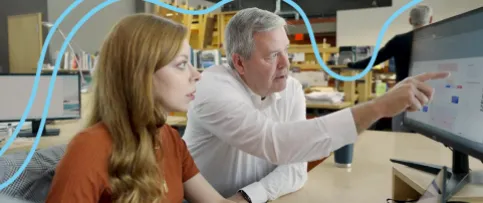Even a brief hiatus from the profession didn’t stop Andrew Malanowski, AIA, NCARB, LEED AP BD+C, from earning his license at 28. Now, the Wisconsin architect has his hands full as an IDP supervisor, licensing advisor, and NCARB committee member. Here, he shares tips for passing the ARE, staying motivated, and connecting with other emerging professionals.
Why did you decide to become an architect?
I always enjoyed trying to figure out how things were built. I also like to draw and build things myself. I think the combination of these hobbies and interests allowed people to point me toward architecture as a career. After graduating from architecture school in the middle of the Great Recession, I took six months off to ensure I was on the right career path. Within that time, I figured out that I did, in fact, miss the profession and wanted to become licensed. I was able to find an internship at a small firm, eventually working my way to where I am today!
How did you earn hours in those “hard to reach” IDP areas?
Persistence. I came to realize that I was the best advocate for my IDP hours. I made sure I conveyed to my supervisors and senior staff where I needed experience. If I heard about an opportunity that could help me earn those hours, I would make it known I wanted to participate. I also attended construction tours through our local AIA component since those can be hard to come by as an intern. Site tours are only a couple of hours, but incredibly valuable.
You passed all seven divisions on the first try. Tell us your study secrets!
I'm not sure I have any secrets to share! I took my testing and studying very seriously. I wanted to get the ARE done, and I only wanted to do it once. I found a rhythm that worked for me and stuck with it through the seven exams. I always concentrated my studying into a few intense weeks instead of drawing it out for a month or two. I took a little time off between each exam to recharge, eventually completing all divisions in 11 months.
I almost always took the exams early in the week—usually Mondays—because I knew I would be the most rested and least distracted by the workweek. While it wasn't always fun and was a lot of work, studying for the exams wasn't all that bad. I found (most) of the information at least a little interesting, which is more than I can say for some other exams back in school! I'm sure finding the topics interesting helped me learn and retain the materials.
Studying was a commitment. And just like anything else I commit to, I knew I had to make sure I stuck with it if I was going to be successful. It wasn't always easy, but I did it. And now I have that freedom to do everything else I put off that year. One secret I can share: I took most of my exams in the fall, winter, and spring. I took one exam in the summer, which was terrible because all I wanted to do was be outside. There were fewer distractions in the winter, so I actually used Wisconsin’s seasons to my advantage!
You served on the 2014 NCARB Award Jury and ARE 5.0 Mapping Subcommittee. Why is giving back to the profession important to you?
A lot of people don’t realize how much say architects have in NCARB’s programs. The profession is constantly changing, and our programs need to change with it if we want to stay current. Architecture is my profession. I have a vested interest in what it is today and what it could be tomorrow. Being part of these changes is a big honor and responsibility. Even as someone who’s recently licensed, I found I had a lot to contribute to these committees. The best part is having a direct effect on the future of the profession.
Where can interns connect with other emerging professionals?
The best way I have found is through the local or state AIA component. I used our local AIA as a resource when I was a new graduate in town to meet others in the profession. Our AIA chapter sponsors ARE prep sessions, construction tours, lectures, happy hours, design competitions, and manages its own ARE study library. I hear feedback from other interns that just seeing the critical mass of others interested in the profession makes them realize they aren't alone—at times, reinvigorating their passion and desire to be involved and get their license.
As a licensing advisor, how do you keep interns motivated?
I don’t let them make excuses by providing plenty of opportunities to earn IDP hours. Supplemental experience is a great way to get internship credit outside of the office. Experiences that fall under this category include design competitions, completing activities in the Emerging Professionals Companion (EPC), and volunteering at community-based design centers, to name a few.
I also share my personal experiences with the license process to show them that their career goals are achievable. I often get asked, "Is it worth it?" My response is "Absolutely.” Achieving licensure is extremely gratifying, and it can open doors in your personal and professional life. We work so hard to get through school, complete IDP, and pass the AREs—getting licensed is just the final step.
What’s the best piece of career advice you’ve ever been given?
You are your own best advocate. No one is going to hand you IDP hours, pass the ARE, find you a job, make you a better architect, or make you stand out. You can be or do whatever you want. Don't take “no” as a final answer. Only you control what you can or cannot do.



